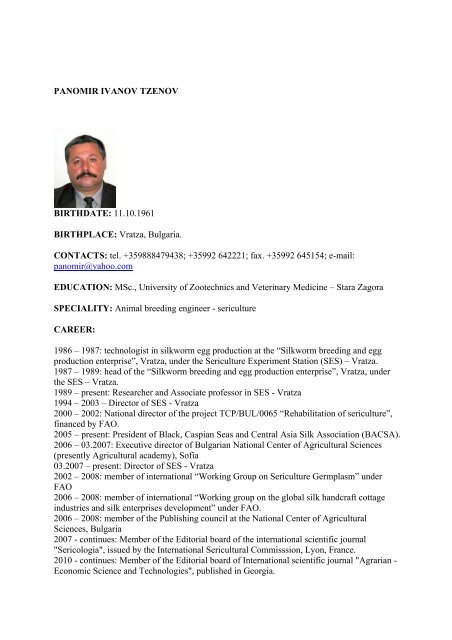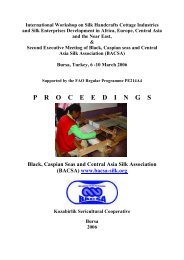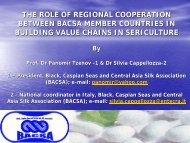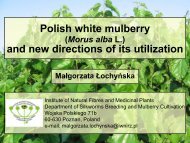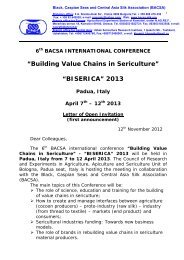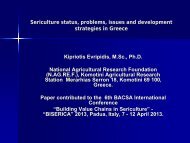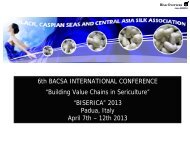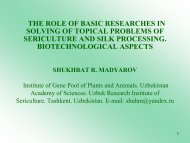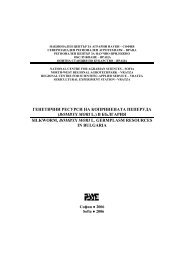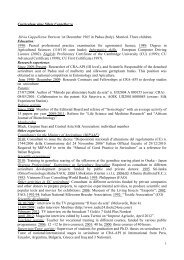PANOMIR IVANOV TZENOV - Bacsa-silk.org
PANOMIR IVANOV TZENOV - Bacsa-silk.org
PANOMIR IVANOV TZENOV - Bacsa-silk.org
Create successful ePaper yourself
Turn your PDF publications into a flip-book with our unique Google optimized e-Paper software.
<strong>PANOMIR</strong> <strong>IVANOV</strong> <strong>TZENOV</strong><br />
BIRTHDATE: 11.10.1961<br />
BIRTHPLACE: Vratza, Bulgaria.<br />
CONTACTS: tel. +359888479438; +35992 642221; fax. +35992 645154; e-mail:<br />
panomir@yahoo.com<br />
EDUCATION: MSc., University of Zootechnics and Veterinary Medicine – Stara Zagora<br />
SPECIALITY: Animal breeding engineer - sericulture<br />
CAREER:<br />
1986 – 1987: technologist in <strong>silk</strong>worm egg production at the “Silkworm breeding and egg<br />
production enterprise”, Vratza, under the Sericulture Experiment Station (SES) – Vratza.<br />
1987 – 1989: head of the “Silkworm breeding and egg production enterprise”, Vratza, under<br />
the SES – Vratza.<br />
1989 – present: Researcher and Associate professor in SES - Vratza<br />
1994 – 2003 – Director of SES - Vratza<br />
2000 – 2002: National director of the project TCP/BUL/0065 “Rehabilitation of sericulture”,<br />
financed by FAO.<br />
2005 – present: President of Black, Caspian Seas and Central Asia Silk Association (BACSA).<br />
2006 – 03.2007: Executive director of Bulgarian National Center of Agricultural Sciences<br />
(presently Agricultural academy), Sofia<br />
03.2007 – present: Director of SES - Vratza<br />
2002 – 2008: member of international “Working Group on Sericulture Germplasm” under<br />
FAO<br />
2006 – 2008: member of international “Working group on the global <strong>silk</strong> handcraft cottage<br />
industries and <strong>silk</strong> enterprises development” under FAO.<br />
2006 – 2008: member of the Publishing council at the National Center of Agricultural<br />
Sciences, Bulgaria<br />
2007 - continues: Member of the Editorial board of the international scientific journal<br />
"Sericologia", issued by the International Sericultural Commisssion, Lyon, France.<br />
2010 - continues: Member of the Editorial board of International scientific journal "Agrarian -<br />
Economic Science and Technologies", published in Ge<strong>org</strong>ia.
SCIENTIFIC QUALIFICATION: 1989 – Research Officer ІІІ degree; 1991 – Research<br />
Officer ІІ degree; 1994 – Research Officer І degree; 1996 – PhD - sericulture; 1998 –<br />
Associate professor - sericulture; 2012 - Professor - sericulture<br />
KEY EXPERIENCE AND EXPERTISE: general sericulture: <strong>silk</strong>worm breeding, egg<br />
production, rearing technology, cocoon and <strong>silk</strong> processing;<br />
MAIN SCIENTIFIC CONTRIBUTIONS: Development methodology of <strong>silk</strong>worm<br />
breeding for higher tolerance to unfavorable rearing conditions. Selection of <strong>silk</strong>worm breeds<br />
and hybrids with higher tolerance to physical stress. Selection of <strong>silk</strong>worm breeds and hybrids<br />
having higher cocoon and shell weight, shell ratio, filament length and raw <strong>silk</strong> percentage.<br />
Breeding 5 new <strong>silk</strong>worm sex-limited pure lines and one four – way F1 hybrid.<br />
Determining the effect of the genotype and environment on the mulberry leaf ingestion,<br />
digestion and utilization in different Bulgarian <strong>silk</strong>worm breeds and hybrids, the effect of<br />
interactions genotype – environment on the phenotypic expression of the genes, responsible<br />
for <strong>silk</strong>worm diapause, the effect of some environment factors on the <strong>silk</strong>worm fecundity.<br />
Investigations on possibilities for producing of compost by the wastes from <strong>silk</strong>worm rearing,<br />
such as mulberry leaf remnants, shoots, branches and <strong>silk</strong>worm excrements, and establishing a<br />
technology for wasteless cocoon production in the sericultural farm.<br />
Development of a method for determination the balance of nitrogen in <strong>silk</strong>worm body and<br />
nitrogen obtained by 0.1 ha mulberry plantation which will take place in scientific<br />
investigation as model for establishment of new technological decisions for producing of<br />
maximal amount of proteins in the form of cocoons and raw <strong>silk</strong>.<br />
Studies on the influence of different <strong>silk</strong>worm breeds and hybrids, terms of beginning the<br />
spring <strong>silk</strong>worm rearing and increased concentrations of heavy metals in mulberry leaves on<br />
the mulberry leaf ingestibility, digestibility and utilization by the <strong>silk</strong>worms.<br />
Working out of labor – saving technologies for <strong>silk</strong>worm rearing and industrial methods of<br />
<strong>silk</strong>worm egg production.<br />
Working out of cottage based technology for cocoon drying, <strong>silk</strong> reeling and processing,<br />
suitable for the Bulgarian conditions.<br />
ABROAD MISSIONS AND QUALIFICATIONS:<br />
1988: Ukraine, Agricultural academy, Sericulture Research Institute, Merefa, Kharkov district,<br />
Silkworm egg production enterprise in Mirgorod – 20 days<br />
1991: Ukraine, Agricultural academy, Sericulture Research Institute, Merefa, Kharkov district,<br />
participation at international conference on the world sericulture industry problems – 7 days<br />
1995: Republic of Korea, Sericulture and Entomology Research Institute, Suwon,<br />
participation at sericulture training course – 45 days.<br />
1998: Greece, Agricultural Research Station, Komotini, head of joint research project – 5<br />
days.<br />
1998: Ukraine, Agricultural academy, Sericulture Research Institute, Merefa, Kharkov district,<br />
participation at international sericultural conference – 7 days<br />
1998: Egypt, Agricultural company “Agromier”, Cairo, head of joint research project – 7 days.<br />
1999: Egypt, participation at the 18th congress of the International Sericultural Commission –
7 days<br />
2000: Greece, Agricultural research station, Komotini, head of joint research project – 5 days.<br />
2002: (February) Thailand, Bangkok, Ministry of Agriculture, Department of Agricultural<br />
Extension, specialization in sericulture management and extension service, 10 days.<br />
2002: China, Hangzhou, Zhejiang National University, specialization in training of university<br />
students in sericulture, and general sericulture, 10 days<br />
2002: South Korea, Suwon and Daegu, Kyung – puck National University, specialization in<br />
<strong>silk</strong> processing and production of ready garment, 10 days.<br />
2002: (September) Thailand, Bangkok, 19th congress of the International Sericultural<br />
Commission & The first international conference on Conservation Status of Sericulture<br />
Germplasm of the World, <strong>org</strong>anized and supported by the FAO, participation as invited<br />
lecturer, 7 days.<br />
2002: Greece, Thessalonica, 7th European congress in entomology, scientific conference:<br />
New prospects of the European sericulture”, participation as invited lecturer, 5 days.<br />
2002: Greece, Athens, International sericulture conference, participation with scientific paper,<br />
4 days.<br />
2003: Italy, Rome, FAO, International consultant of FAO, 7 days.<br />
2003: Azerbaijan, International consultant of FAO, 7 days.<br />
2003: Ge<strong>org</strong>ia, International consultant of FAO, 7 days.<br />
2003: Uzbekistan, International consultant of FAO, 7 days.<br />
2004: Italy, Rome, International consultant of FAO, 3 months.<br />
2005: Italy, Rome, International consultant of FAO, 4 months.<br />
2005: Uzbekistan, Tashkent, FAO consultant in <strong>org</strong>anization of “International Workshop on<br />
Revival and Promotion of Sericultural Industries and Small Enterprise Development in the<br />
Black, Caspian Seas and Central Asia Region”, Tashkent, Uzbekistan 11 - 15 April 2005, 15<br />
days<br />
2005 – 2006: Bulgaria and Turkey, FAO consultant on the <strong>silk</strong> handcraft cottage industries<br />
and small <strong>silk</strong> enterprises development and co-<strong>org</strong>anizer of “International Workshop on Silk<br />
Handcrafts Cottage Industries and Silk Enterprises Development in Africa, Europe, Central<br />
Asia and the Near East & Second Executive Meeting of Black, Caspian seas and Central Asia<br />
Silk Association (BACSA)” Bursa, Turkey, 6 -10 March 2006<br />
2006: Romania, Bucharest, participation at the 4th meeting of the Union of European<br />
Academies for Science Applied to Agriculture, Food and Nature and visit the commercial<br />
society “Sericarom”, 4 days.<br />
2007: Greece, Agricultural Research Station, Komotini, joint research project – 4 days.<br />
2007: Japan, Kyushu University and Kyoto University: visit the National <strong>silk</strong>worm gene bank<br />
of Japan, participation with a paper at an international meeting on the global problems of<br />
conservation and utilization of <strong>silk</strong>worm genetic resources, 7 days.<br />
2007: Romania, August, Bioengineering, Biotechnology and Environment Protection Institute,<br />
Bucharest, participation in an international conference as invited speaker and chairman of<br />
section.<br />
2007: Thailand, Bangkok, participation as an invited speaker at the Thai Silk Fair 2007,<br />
August, 7 days<br />
2007: Romania, November, visit the University of Agricultural Sciences and Veterinary<br />
Medicine, Cluj Napoka and participation at the "36th International Session of Scientific<br />
Communications", <strong>org</strong>anized by the University of Agricultural Sciences and Veterinary<br />
Medicine, Bucharest, 7 days<br />
2008: India, March, participation at the "International Conference on Trends in<br />
Seribiotechnology, 27 - 29, March, SK University, Anantapur, India, 7 days<br />
2008: Bahrain, March, survey on the local <strong>silk</strong> market, 2 days
2008: Romania, April, participation at the international conference "Sericulture in the 3rd<br />
millenium - tradition and modern biotechnology in FP 7", 17 - 18 April, University of<br />
Agricultural sciences and Veterinary Medicine, Cluj Napoca, 4 days<br />
2008: Romania, participation at the international conference "Exploitation of agricultural and<br />
food industry by - products and waste material through the application of modern processing<br />
techniques", 1 - 3 July, Bucharest.<br />
2008: Greece, participated at the 21st Congress of the International Sericultural Commission,<br />
3 - 6 November, Athens.<br />
2009: Romania, participated at the international workshop "Use of sericulture wastes and by<br />
products in phytotherapy and other non - textiles purposes", S.C.BIOING S.A. 2-3 April 2009,<br />
Bucharest, Romania<br />
2009: Moldova, visited the Moldavian Academy of Sciences, April.<br />
2009: China, participation in the 2009 China International Silk Forum, 18 - 20 October,<br />
Hangzhou and visit different sericultural sites in China, 10 days.<br />
2010: Thailand, participation at "ASEAN Sericulture Conference 2010 and ASEAN Silk<br />
Fabric and Fashion Design Contest 2010", 22 - 27 August, Nontaburi, Thailand, 10 days.<br />
2010: USA, visited Entogenetics Inc., Charlotte, North Carolina, November, 10 days.<br />
2011: Romania, participation at the International conference "Sericulture for multi products -<br />
new trends for development" and the 5th BACSA meeting, Bucharest, Apil, 5 days.<br />
2011: Romania, participation in the international workshop “Sericulture and agriculture –<br />
strong relationships between Bulgaria, Greece and Romania”, September, Bucharest, 3 days.<br />
2011: Thailand, participation in 22nd Congress of International Sericultural Commission, 14 –<br />
18 December, Chiang Mai, 10 days.<br />
NUMBER OF SCIENTIFIC PUBLICATIONS: 189, including 57 abroad, 9 books and<br />
monographs, 2 abroad, many popular papers.<br />
Author’s certificates for new commercial <strong>silk</strong>worm hybrids: – 5.<br />
Foreign languages: English and Russian in writing and speaking


